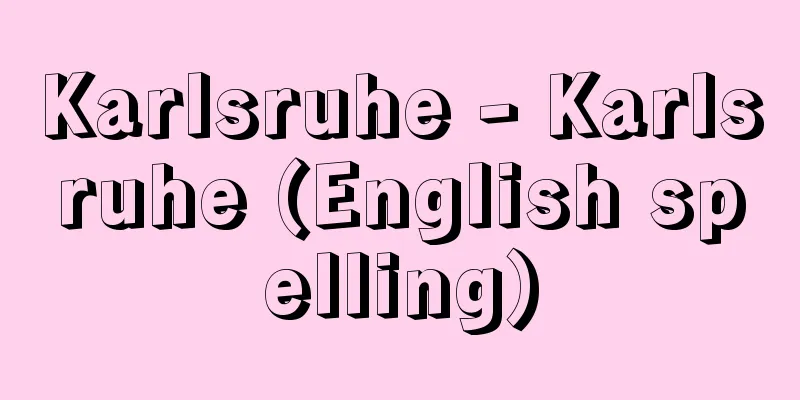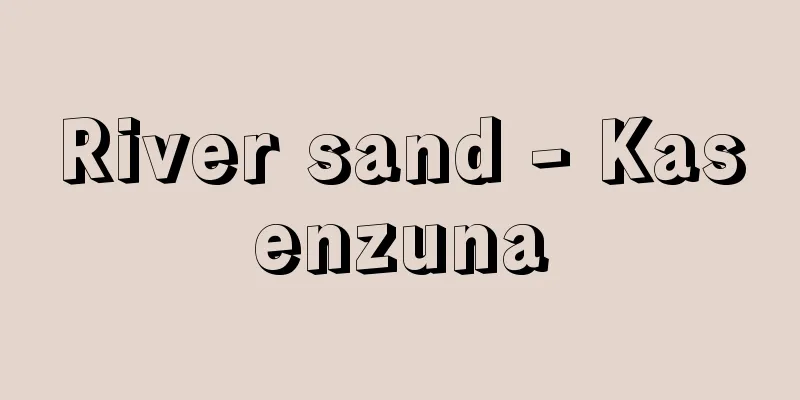Casting - Chuzo (English spelling) casting

|
Metal is heated and melted, then poured into a mold with the desired shape, and cooled and solidified to create a product, making it one of the most important metal processing methods along with plastic processing, powder metallurgy, welding, etc. Furthermore, since molten metal can take on any complex shape depending on the shape of the mold, there are a great many metal products around us that are made by casting, such as complex-shaped industrial products and art and craft items that are created according to the creative will of the creator. These are collectively called castings. Castings may be heat-treated after the molten metal has solidified, but no further deformation is done through plastic processing or the like, and they must have sufficient strength in the solidified structure, i.e., the cast structure. Therefore, they are characterized by a relatively high amount of alloys to create a two-phase structure. Examples include cast iron, which contains more carbon and silicon than steel, and aluminum alloy castings, which also contain 10% or more silicon. Copper alloys can also contain up to 10% tin in bronze castings, and up to 40% zinc in brass castings. [Katsuya Igawa] Casting FurnaceA crucible furnace or a low-frequency electric furnace is used to melt aluminum alloys and copper alloys. A crucible furnace burns heavy oil or coke around a graphite crucible, and has a simple structure and has been used for a long time. A low-frequency induction electric furnace runs alternating current with a frequency of 50 or 60 Hz from a normal power grid through a primary coil wound around an iron core, and heats the metal by inducing a large current through a channel in the gap between the iron core as a short-circuit secondary circuit. An upright cylindrical furnace called a cupola has long been used to melt cast iron. Coke and ingots are placed inside the furnace, air is pumped in, the coke is burned to melt the ingots, and the molten metal is taken out from the bottom of the furnace. Also, crucible-type low-frequency electric furnaces have been widely used since around 1960. Unlike the channel type mentioned above, this does not use an iron core, but instead has a coil wound around the outside of a crucible-type furnace, which is passed through a low-frequency current to induce a secondary current in the cast iron inside the crucible, causing it to heat up and melt. To melt steel, a Herault-type electric arc furnace using three-phase alternating current or a crucible-type high-frequency induction furnace using alternating current with a frequency of 1000 Hz or more is used. The molten metal produced by these furnaces is transferred to refractory-lined ladles, conveyed to the moulds and poured into the moulds by either tilting the ladle or by lifting a stopper at the bottom of the ladle. This process is called pouring. [Katsuya Igawa] templateMeanwhile, molds are being made. The most commonly used mold material is foundry sand, which is made mainly of silica sand, with other special sands such as zircon sand, olivine sand, and chromite sand also being used. Sand with a grain size of around 20-70 mesh is mixed with 4-8% clay as a binder and 2-6% water, then thoroughly kneaded to make green sand. A model of the same shape as the casting to be made is made out of wood, plastic, or metal, and is called the master model. However, since the metal that has solidified to the mold dimensions shrinks as it cools to room temperature, the master model must be made accordingly larger. The ratio is 1.5-2% for steel castings, 0.5-1% for cast iron castings, 0.8-1.5% for copper alloy castings, and 0.9-1.75% for aluminum alloy castings. Therefore, when making a prototype out of wood at a mold factory, a ruler with longer markings is used, which is called a casting ruler or extended ruler. [Katsuya Igawa] Molding MachineThis original model is placed on a surface plate, a molding flask is placed inside, green sand is poured into it, and the mold is then completed by removing the original model. Hammering by hand is called "tekome," but nowadays various molding machines are used. To give the simplest example, first the lower half of the master model is used to fill the green sand mold with the impact force of up and down vibration. This is then inverted, and green sand is placed on top of the upper mold model, and the squeeze head and table are brought close together to squeeze the sand into the upper mold. Next, the match plate on which the model is attached is vibrated while the upper mold is removed from the model and placed on a side bench, and then the match plate and lower mold model are similarly vibrated while being removed from the lower mold. At this point the necessary core is placed inside, the upper mold is covered, and a molten metal basin is placed on top to make casting easier, or the flask is removed if it is not needed, and the mold is complete. When pouring molding sand on top of a model, it is common to cover the model with a certain thickness of molding sand made with particularly fine sand in order to make the surface of the product fine. This sand is called hadasuna (surface sand), and the sand poured behind it is called urasuna (back sand). [Katsuya Igawa] Casting methodThe mold has a spout for pouring the molten metal into it, a horizontal runner for the molten metal to flow vertically around the mold cavity that will become the product, and a gate for the metal to flow from the runner into the mold cavity. As the molten metal fills the cavity and begins to solidify, the metal generally shrinks, so to make up for the lack of molten metal, a riser is placed near the part of the product that will solidify last. The design of each of these parts of the mold has a significant impact on the success of the casting. This type of mold design is called the casting plan. To increase the effectiveness of the riser, various casting plan ideas are used, such as inserting chills into the mold to quickly cool the necessary parts, or adding excess material to slowly cool the necessary parts, while giving careful consideration to the solidification order of the casting. In addition, the formation of blowholes in the castings caused by gases released when the metal solidifies or absorbed by the mold must be avoided, so it is necessary to drill small holes in the mold to vent gases, use coarse sand to improve the mold's breathability, dry the mold, or degas the molten metal before pouring. When the product that has solidified inside the mold is removed, sand and other particles will be found adhering to the surface, so in order to clean this, steel particles are fired at it (shot blasting) or a mixture of sand and water is fired at it (hydroblasting). [Katsuya Igawa] New casting methodThis is how products are made by casting, but the productivity of a foundry is largely determined by the molding process, which is the most labor-intensive and time-consuming process, so various methods have been developed to streamline and increase the efficiency of this process. One of these is the low pressure casting method. In this method, a metal mold or a reusable refractory mold is placed above a molten metal holding furnace and the spout is extended downward and immersed in the molten metal. The entire apparatus is placed in an airtight chamber, and when a pressure slightly higher than atmospheric pressure is applied to the surface of the molten metal, the molten metal rises through the spout and is forced up into the mold. After it solidifies in the mold, the pressure on the surface of the molten metal is removed and the unsolidified molten metal in the spout returns to the holding furnace. This method has a good molten metal yield and can be used with copper alloys that have relatively high melting points, so it is expected to develop as a new casting method. Next, the binder for green sand molds is clay and water, but stronger binders that do not require heavy tamping are now being used. Inorganic binders include sodium silicate, cement, and gypsum, while organic binders include furan resin, phenolic resin, and drying oil. [Katsuya Igawa] [Reference] | |Jolt is a process in which the green sand mold is pounded by applying vibration. Squeezing is a compression process in which pressure is applied between the squeeze head and the table to compact the sand in the upper mold. ©Shogakukan "> Casting process (molding using a molding machine) Source: Shogakukan Encyclopedia Nipponica About Encyclopedia Nipponica Information | Legend |
|
金属を加熱して溶融し、これを目的の形をもたせた鋳型に流し込み、冷却、凝固させて製品をつくる方法で、塑性加工、粉末冶金(やきん)、溶接などと並ぶ重要な金属加工法の一つである。しかも溶融金属は鋳型の形状に応じていかなる複雑な形をもとりうるので、形状複雑な工業製品や、製作者の創作意欲のままにつくりあげられる美術工芸品など、われわれの身の回りには鋳造によってつくられた金属製品はきわめて多い。これらを総称して鋳物という。 鋳物は溶融金属が凝固したあとは熱処理を施すことはあるが、塑性加工などによりそれ以上の変形を加えることはなく、凝固したままの組織で、すなわち鋳造組織で十分な強度をもたねばならない。したがって二相組織などにするため比較的合金量が多いのが特徴である。鋳鉄は鋼よりも炭素量、ケイ素量が多く、アルミニウム合金鋳物も10%以上のケイ素を含むなどがその例である。また銅合金も青銅鋳物では10%までのスズを含み、黄銅鋳物では40%までの亜鉛を含む。 [井川克也] 鋳造炉アルミニウム合金、銅合金の溶融にはるつぼ炉や低周波電気炉が用いられる。るつぼ炉は、黒鉛製のるつぼの周囲で重油あるいはコークスを燃焼させるもので、構造が簡単で古くから使われている。低周波誘導電気炉は、通常の配電網の50または60ヘルツの周波数の交流を鉄心に巻いた一次コイルに流し、鉄心の間隙(かんげき)に設けたチャンネルとよばれる溶湯の道を短絡二次回路として大電流を誘導させて昇温する。鋳鉄の溶融にはキュポラcupolaとよばれる直立した円筒形炉が古くから用いられている。この中にコークスと地金とを入れて空気を送り込み、コークスを燃焼させて地金を溶融し炉底から溶湯を取り出す。また、1960年ごろから、るつぼ型低周波電気炉が広く用いられている。これは前述のチャンネル型とは異なり鉄心を用いず、るつぼ型の炉の外周にコイルを巻き、これに低周波電流を流し、るつぼ内の鋳鉄に二次電流を誘起させて昇温溶融させる。鋼の溶融には三相交流を用いるエルー式電気アーク炉あるいは1000ヘルツ以上の周波数の交流電流を用いるるつぼ型高周波誘導電気炉を用いる。 これらの炉によって溶融された金属は、耐火れんがで裏張りされた取鍋(とりべ)に移され、鋳型のところまで運搬され、取鍋を傾けるか、あるいは取鍋の底につけたストッパーを引き上げることによって、鋳型に注入される。これを鋳込みという。 [井川克也] 鋳型一方では鋳型の製作が行われる。もっともよく使われる鋳型材料は鋳物砂(いものずな)とよばれる珪砂(けいさ)を主体とするもので、このほか特殊なものとしてはジルコン砂、オリビン砂、クロマイト砂なども用いられる。20~70メッシュ前後の粒度の砂に粘結剤として粘土を4~8%、水分を2~6%加えよく混練して生型(なまがた)用砂とする。つくろうとする鋳物と同じ形状をした模型を木、プラスチックまたは金属でつくり、これを原型と称する。ただし、鋳型寸法で凝固した金属は室温まで冷却する間に収縮するので、原型はその分大きくつくっておかねばならない。その割合は鋼鋳物で1.5~2%、鋳鉄鋳物で0.5~1%、銅合金鋳物で0.8~1.5%、アルミニウム合金鋳物で0.9~1.75%である。したがって原型模型を木でつくる場合の木型工場では、あらかじめこの分長く目盛った物差しを使い、これを鋳物尺または伸尺(のびじゃく)という。 [井川克也] 造型機この原型を定盤の上に置き、鋳枠を置いてこの中に生型用砂を入れてよく搗(つ)き固め、その後原型を抜き取れば、鋳型が完成する。人力で搗き固めることを手込めというが、現在では種々の造型機(モールディングマシン)を用いる。 そのもっとも簡単なものを一例としてあげると、まず下半分の原型を用いて生砂型を上下振動の衝撃力によって込める。これを反転し、上型の模型の上に生型用砂を入れてスクイズヘッドとテーブルとを近づけて上型の砂を締め付けて込める。次に模型を取り付けた定盤(マッチプレート)に振動を加えながら上型を模型から抜き上げてサイドベンチに置き、ついで定盤と下型模型とを同じく振動を与えながら下型から抜き取る。ここで必要な中子(なかご)を収め、上型をかぶせ、鋳込みやすいように湯溜(ゆだま)りをのせたり、鋳枠が不要な場合は抜き取ったりして、鋳型が完成する。 模型の上に鋳型砂を込める場合、製品の鋳肌をきめ細かなものにするため、とくに細かい砂で調製した鋳物砂をある厚さで模型の上にかぶせることがよく行われる。この砂を肌砂(はだすな)といい、その後ろ側に込める砂を裏砂(うらすな)という。 [井川克也] 鋳造方案鋳型の溶湯を流し込むための湯口(ゆぐち)、垂直に流れ込んだ溶湯が製品となるべき鋳型空洞の周りに流れていくための水平な湯道(ゆみち)、さらに湯道から製品の鋳型空洞に流れ込むための堰(せき)、製品となるべき空洞を溶湯が満たし、凝固が始まると金属は一般に収縮するので、それにより不足する溶湯を補う目的で押湯(おしゆ)という部分を、製品の最後に凝固する箇所付近に余分につけておく。これら一連の鋳型各部の設計は鋳物作りの成否に大きく影響する。このような鋳型の設計を鋳造方案という。押湯の効果を高めるためには、鋳物の凝固順序を十分考慮し、冷やし金(がね)を鋳型中に入れて必要部分を早く冷やしたり、余肉をつけて必要部分を徐冷したりするなど鋳造方案上の種々のくふうがなされる。また金属の凝固時に放出されるガスや鋳型から吸収されるガスによって生ずる鋳物の気泡巣(ブローホールblow hole)の形成も避けねばならないので、鋳型に細い孔(あな)をあけてガス抜きとしたり、粗めの砂を使って鋳型の通気度をよくしたり、あるいは鋳型を乾燥したり、溶湯を鋳込み前に脱ガスしたりする必要がある。 鋳型内で凝固した製品を取り出すと表面に砂などが付着しているので、これを清掃するために鋼粒をぶつけたり(ショットブラストshot blasting)、砂と水の混合物をぶつけたり(ハイドロブラストhydroblasting)する。 [井川克也] 新しい鋳造法このようにして鋳造によって製品がつくられるが、鋳物工場の生産性は、もっとも人手と時間のかかる造型工程に支配される面が大きい。そのためこれを合理化し能率化するために種々の方法が開発されてきた。 その一つに低加圧鋳造法がある。これは、金型あるいは繰り返し使用できる耐火物製鋳型を溶湯保持炉の上に設置し、湯口を下に伸ばして溶湯中に浸漬(しんせき)する。装置全体を気密室に収め、溶湯面に大気圧よりわずかに高い圧力をかけると、溶湯は湯口中を上昇し、鋳型中に押し上げられる。鋳型中で凝固したのち、溶湯面の圧力を除くと、湯口中の未凝固溶湯は保持炉中に戻る。この方法は溶湯歩留りもよく、比較的高融点の銅合金にも使えるので新しい鋳造法として発展が見込まれている。 次に生砂型の粘結剤は粘土と水であるが、さらに強力でしかも強い搗き固めを要しない粘結剤が使われるようになってきた。無機質粘結剤としてはケイ酸ソーダ、セメント、石膏(せっこう)などであり、有機質粘結剤としてはフラン樹脂、フェノール樹脂、乾性油などである。 [井川克也] [参照項目] | |ジョルトは、振動を与えて生砂型を搗き固める工程。スクイズは圧縮工程で、スクイズヘッドとテーブルの間に圧力をかけ、上型の砂を締め付ける©Shogakukan"> 鋳造の過程(造型機による造型) 出典 小学館 日本大百科全書(ニッポニカ)日本大百科全書(ニッポニカ)について 情報 | 凡例 |
Recommend
Polotsk (English spelling)
A city in the Vitebsk Oblast in northern Belarus. ...
Silk and cotton mixed weave
〘 noun 〙 Silk and cotton mixed weaving. Also, a ge...
The Beautiful Mill Girl
Austrian composer Franz Schubert's song cycle ...
Embezzlement - embezzlement
In the narrow sense, it refers to the crime of ta...
Wladyslaw Lokietek (English spelling)
…Henryk IV Probus (c. 1257-1290, who aspired to t...
Notsu [town] - Notsu
An old town in Ono County, southeastern Oita Prefe...
Guernsey [island] - Guernsey
An island in the southern part of the English Chan...
Stone money - Sekka
Valuables for exchange in Yap, Micronesia. In thi...
Vascular cambium - Vascular cambium
…the meristem involved in the growth of stems and...
Articular disc
A fibrous plate of tissue that facilitates joint m...
Ironsides
… In 1542, when the First Civil War broke out, he...
Ihimaera, W. (English spelling) IhimaeraW
…In recent years, Māori writers who have awakened...
Dignāga (English spelling)
[Birth] 480 yen [Died] circa 540. Established a ne...
Rhynchobatus djiddensis (English spelling) Rhynchobatusdjiddensis
…They feed on small animals such as crustaceans. ...
Dumaguete
...The mountain range that runs north to south al...









